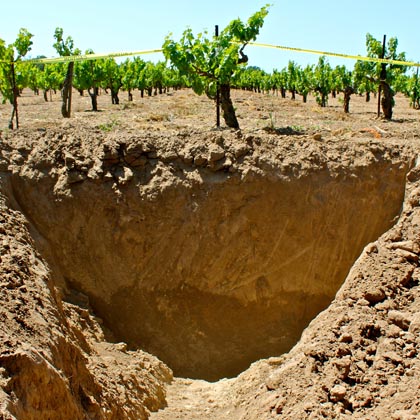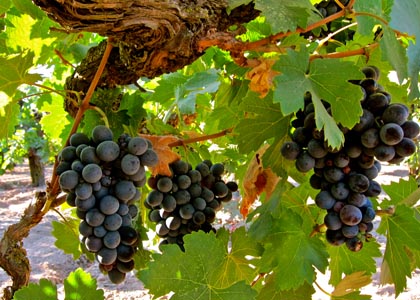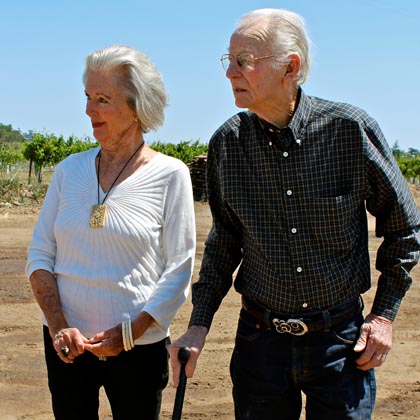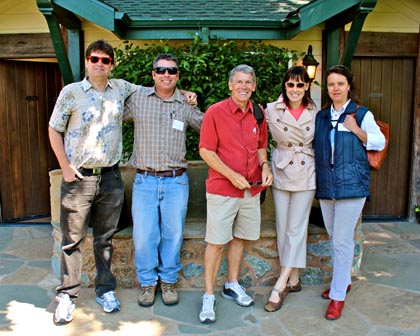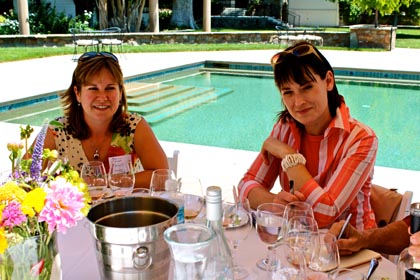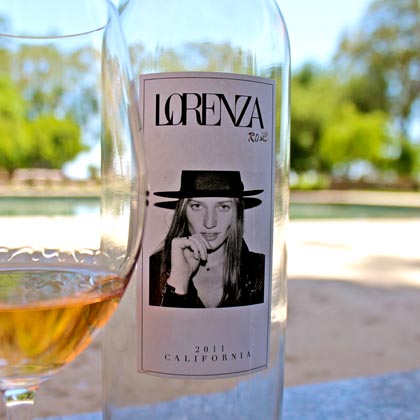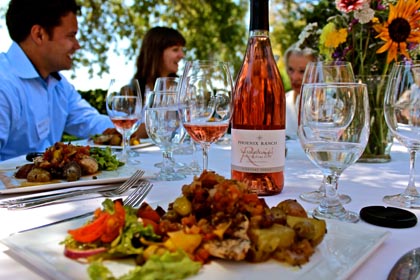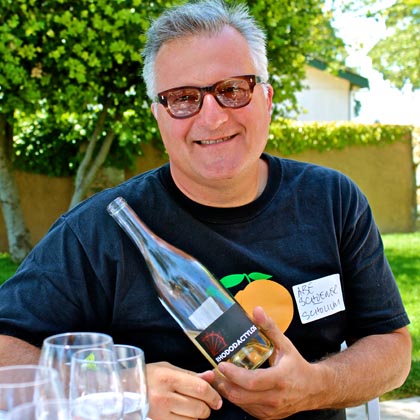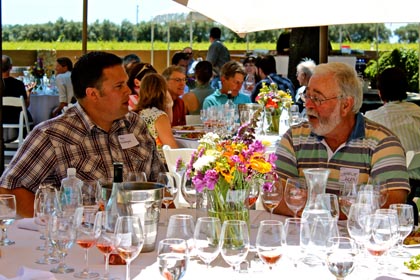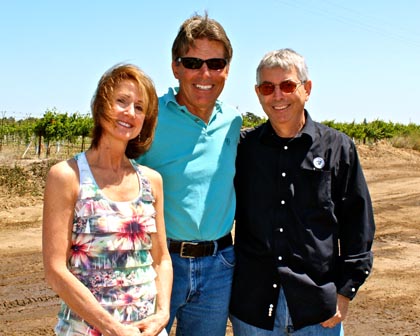Letters from Lodi
An insightful and objective look at viticulture and winemaking from the Lodi
Appellation and the growers and vintners behind these crafts. Told from the
perspective of multi-award winning wine journalist, Randy Caparoso.
Phillips Farms hosts star winemakers & press at historic Bechthold Vineyard tribute
Backhoed hole showing deep sandy loam beneath ancient Bechthold vines
Last week Wednesday, May 23, 2012, Phillips Farms, the agricultural arm of Michael-David Winery, hosted a gathering of eight other stellar winemakers and ten influential wine journalists in a vineyard walk and tasting of wines from Lodi’s oldest – and perhaps, most revered – vineyard: the Bechthold Vineyard.
Bechthold grown Cinsault, harvest 2011
This historic event was organized and led by Kevin Phillips, Michael-David’s Vice President of Operations. In his capacity, Phillips is in charge of farming the 750 acres owned by Phillips Farms in the Lodi AVA , as well as maintaining relations with the two dozen or so other local growers supplying Michael-David’s myriad wine labels.
Since 2008, Mr. Phillips has devoted a great deal attention on the 25 acres comprising Bechthold Vineyard, which was originally planted by Joseph Spenker in 1886. Think of that – this was the year Grover Cleveland was in the White House, when there were only 38 states, Geronimo was finally laying down his arms after 30 years of fighting, and in Santa Clara County vs. Southern Pacific Railroad, the U.S. Supreme Court ruled that corporations have the same rights as people (maybe things haven’t changed much after all).
The Bechthold Vineyard is planted entirely to the Southern French grape known as Cinsault (also spelled Cinsaut, and pronounced SAN-so). But because for over a century the fruits of Bechthold were identified and sold by an obscure synonym, Black Malvoiser, the grapes were largely undervalued – the vineyard, virtually forgotten – up until very recently.
Just eight years ago Bechthold grown Cinsault grapes were being sold mostly to out-of state home winemakers for less than $200/ton. Today the grapes are valued 20 times higher, and there is a long list of producers within and outside of Lodi vying for part of the yearly crop from this phenomenally old and meticulously tended dry farmed vineyard. To read more about how Bechthold Vineyard, in 2004, was “rediscovered” within the very midst of Lodi’s historic sub-appellation, the Mokelumne River AVA, please see our earlier post entitled The magical Bechthold Vineyard.
Wanda Woock & Al Bechthold
Although the Bechthold planting is in the northern end of what is still called Spenker Vineyard, it is called Bechthold because it was farmed by Al Bechthold, who recently turned 83, from the mid-seventies up until 2008. Mr. Bechthold is married to Wanda Woock Bechthold, 81. Ms. Bechthold – author of Jessie’s Grove: One Hundred Years in the San Joaquin Valley – is the great granddaughter of Joseph Spenker, as well as a partner in Jessie’s Grover Winery, which dominates the southern half of the original square mile of vineyards planted by Spenker in the late nineteenth century (much of the northern end is now owned and farmed by other longtime Lodi families, including the Phillips and Maleys).
On this warm spring morning last week, Mr. Phillips walked the winemakers and journalists through the north side of the vineyard, where both the water table and yields are the lowest – less than 2 tons/acre in a typical year, compared to 4-5 tons at the south end, where the old vines’ roots catch larger draughts from a canal separating Bechthold from the Jessie’s Grove plantings.
Standing next to a 15 ft. deep hole that Phillips had backhoed at the northeast corner of the vineyard – to graphically show how deep and consistent the Mokelumne River’s Tokay sandy loam runs (over 30 ft. deep in much of the AVA) – Ms. Bechthold regaled the visitors with the story of how her great grandfather first arrived from Germany and worked a Foothills gold mine in vain, before coming down to Stockton with 27 cents in his pocket. Spenker worked on a farm, scratching and saving every penny before being able to establish his own property in Lodi, originally planted to wheat and watermelons. “The water table in those days was much higher,” Bechthold points out, “because the rivers were not dammed up as much as they are today, so it was easier to establish a vineyard.”
In the mid-1880s Spenker procured his “Black Malvoise” – as well as Zinfandel and grapes like Carignane, Mission, Black Prince and Tokay – from Stockton nurserymen William and George West, and much of the original acreage that he planted is still in production today, in both the Bechthold and Jessie’s Grove blocks. Also, like most of Lodi’s vineyards planted around the turn of the last century, these European vines were planted on their own rootstocks, as opposed to being grafted on phylloxera-resistant native American rootstocks, since Lodi’s deep sandy soils have never been conducive to the root eating insects that are still ravaging vineyards around the world.
W. Blake Gray, Kevin Phillips, Mike Dunne, Debra Parker Wong & Virginie Boone at Bare Ranch
The Cinsault grape is still highly valued in its native Southern France as a grape component (usually blended with Grenache) in some of the finest dry style rosés in the world – fragrant, silky, and snappy with natural acidity. Following the vineyard walk, during a lunch served at Michael-David’s Bare Ranch, across Woodbridge Rd. from Bechthold Vineyard, Mr. Phillips talked about how the higher yielding south end of the vineyard produces “ideal grapes for pink wines.”
From Bechthold’s middle and north sections, where lower yields produce smaller clusters and berries of more intense flavor, a number of cutting-edge winemakers are now producing a red wine that is strikingly Pinot Noir-like in its delicacy and length of soft tannin structure, with deliciously perfumed flavors that winemaker Jillian Johnson likes to describe as “strawberry rhubarb pie.”
Following the rosé lunch prepared by Ruben Larrazolo of Downtown Lodi’s acclaimed Alebrijes Mexican Bistro, the journalists sat down to a tasting of red wines from the Bechthold Vineyard. The winemakers leading the tasting included:
Kevin Phillips and Adam Mettler, Michael-David Winery
Greg Burns, Jessie’s Grove Winery
Tegan Pasalaqua, Turley Wine Cellars
Gideon Beinstock, Clos Saron
Nick Sikeotis, Estate Crush*
Abe Schoener, The Scholium Project
Jillian Johnson, Phoenix Ranch/Onesta Wines
Adam Webb, Odisea/Cochon Wines
Melinda Kearney, Lorenza Wine
*(Estate Crush in Lodi is where both the Miner’s Leap and the Phoenix/Onesta Cinsaults are produced and bottled)
Jillian Johnson and Debra Parker Wong
The distinguished journalists who were present:
Virginie Boone, Wine Enthusiast Magazine
Jessica Yadegaren, Bay Area News Group
Charlie Olken and Steve Eliot, Connoisseurs’ Guide to California Wine
Tim Patterson, Wines & Vines
Luke Sykora, Wine & Spirits Magazine
Deborah Parker Wong, Tasting Panel Magazine
Mike Dunne, The Sacramento Bee
W. Blake Gray, SF Weekly, Food & Wine Magazine, and The Gray Report
Andy Anderson, bottlenotes
The wines? While varied somewhat according to individual winemaker styles, across the board each bottling was indubitably Cinsault. You can also add the word “magnificently” if, as a wine aficionado, you are capable of appreciating a grape and vineyard such as these without expectations. After all, Bechthold grown Cinsault is not exactly Pinot Noir – its textures as a red wine, not quite so fine or elongated as a typical, fine boned Pinot. Neither is Cinsault like Carignane – at least in the sense that it is rarely so much a promiscuous cherry fruit bomb. And most certainly, Bechthold Cinsaults are a far, far cry from Syrah, Cabernet Sauvignon or Merlot – if you want full scaled opulence, weight or density, you’re looking in the wrong place, my friend.
Bechthold Vineyard Cinsaults comprise a virtual universe unto themselves. Even in France, you will rarely find this grape bottled primarily on its own, like a varietal wine; nor will you ever find, in France, wines made from 126 year old vines like Bechthold’s.
In all likelihood, the qualities tasted in the wines at Michael-David’s presentation are very much a byproduct of a very specific terroir, glimpsed at this particular point in time. Jessie’s Grove’s Greg Burns (Wanda Woock Bechthold’s son) has made a point that 120+ year old vines are simply a different breed, even compared to 80 or 90 year old vines. By virtue of circumstance and age, Bechthold Vineyard has found a rarefied place; almost elixir-like, going by how Jillian Johnson describes how they used these wines when she was the winemaker for Bonny Doon Vineyard: “both pink and red wines from Bechthold were so special, we’d put a little of it in almost every wine we made… there didn’t seem to be a wine that a little Bechthold Cinsault couldn’t improve.”
Our notes on some of the highlights tasted last week:
ROSÉ STYLE WINES
2011 Phoenix Ranch, Bechthold Vineyard Lodi Cinsault Rosé ($18) – 99% pure Bechthold (1% Viognier accentuates flowery notes of the red berry perfume), produced from a saignée in which lightly colored juice (drawn off vats going into production of a red wine) is separated at the press to make a pink wine. Bright pale pink color and palate tingling berry flavors, finishing dry and soothing, like a silk scarf floating on a brisk breeze. Only 85 cases produced (available online or at Estate Crush in Lodi).
Phoenix Rose with Alebrijes' free range chicken
2011 Lorenza, California Rosé ($20) – Only 18% of this wine is Bechthold grown Cinsault (the balance is Grenache, Carignane and Mourvèdre sourced from elsewhere), yet Lorenza proprietor Melinda Kearney referred to Bechthold as the “key” to this exuberantly red fruited, dry, pale pink wine, distinguished by its refreshing lightness (11.8% alcohol) and deftly understated cranberry/strawberry fruitiness.
2011 The Scholium Project, Rhododactylos Phillips Farms California Cinsault Rosé – By contrast, 100% Bechthold grown Cinsault from a relatively cool vintage giving, according to winemaker/owner Abe Schoener, “more delicacy and higher acid than usual.” Creamy white color with only the faintest touch of pale salmon (one journalist blithely asked Schoener, “why do you call it a rosé when it’s obviously a white?), and a remarkably floral, earth toned nose of rose petal and red berries; underscored by wild thyme-ish, faintly animal-like nuances; soft, lush entry evolving into a crisply etched middle taste, finishing refreshingly dry. Simply irresistible, but our only gripe? – it doesn’t say Lodi on the label (which Schoener says is “not a slight” because he uses the broader California designation even with his wines sourced from Napa Valley).
2011 Cochon, California Old Vine Rosé ($21) – Reviewed previously in Odisea’s “Temporary Insanity,” this pale pink wine (blended 45% from Bechthold Cinsault, with 55% Grenache Gris coming from ancient vines in Mendocino’s McDowell Valley) was showing beautifully distinct and breath-like wildflower, strawberry, anise and watermelon fragrances; a crisp, edgy tartness and real sense of lightness on the palate, cushioned by mildly fleshy, almost voluptuous textures resulting from three months in 300 liter, neutral hogshead (hence, cochon – French for “pig”) barrels.
The Scholium Project's Abe Schoener
RED WINES
2011 Onesta, Bechthold Vineyard Lodi Cinsault ($24; barrel sample) – This red wine was originally made by Jillian Johnson for the Phoenix Ranch label, but will be bottled this coming July under her new brand, Onesta Wines (Johnson is currently in the process of divesting herself from Phoenix). In this, our second recent opportunity to taste from the barrel, the wine is showing fantastic complexity: vivid purplish ruby color, a classic Bechthold Cinsault nose of strawberry/rhubarb fruit studded with black peppercorn and cardamom/vanilla spices, and velvety, layered flavors within a moderate tannin/medium weight body. For all its roundness, this is as “full” as a Bechthold Cinsault gets, owing to Johnson’s approach (particularly the approximately 15% saignée bleeds she employs each year) as well as to the fact that she sources from the lowest yielding, northeast corner of the vineyard, where the vines are smallest, producing berries with the highest skin to juice ratios.
2010 Clos Saron, Out of the Blue California Cinsault – This is the first vintage produced by Clos Saron’s Gideon Beinstock; a minimalist winemaker to something of an extreme (he believes in wild yeast fermentation and usage of no sulfites, even at bottling), known for equally iconic work as a Sierra Foothills winemaker specializing in Pinot Noir (that very un-Foothills-like grape). Be as it may, the startling success of this Bechthold grown bottling (co-fermented with 11% Syrah from the Foothills) shows how well suited Beinstock is to this grape and vineyard: super-spicy peppery notes suffused to sweet violet and raspberry perfumes, veering towards Bing cherry, with undertones of minty pyrazine (i.e. compounds suggesting weediness); zesty acid balance and soft tannins bracing a medium weight body, plus a joyously pure sense of immediacy in the taste.
2010 Michael-David, Bechthold Vineyard Lodi Ancient Vine Cinsault ($24) – While Michael-David has forged its reputation with unrepentantly full, often oaky, fruit charged red wines, they throw everything out the window in their handling of this, the only vineyard designated wine in their entire portfolio. Even the use of medium-toast, tight-grain, two year old French oak does not detract from the gushy, sweet concentration of red berry aromas in this violet rimmed red; the fruit qualities coming across as bouncy, almost fat, on the palate, fleshy in texture despite firming tannins. Vinified with about 8% saignée.
Tegan Passalacqua and Charlie Olken
2010 Turley, El Porrôn Lodi Cinsault ($17) – Turley winegrower Tegan Passalacqua has never made any bones about the fact that he strives for a Beaujolais grand crus inspired style of strong yet easy drinking red wine in the Bechthold grown Cinsault – one that is totally proper to drink straight from a porrôn (the traditional, spouted glass Spanish decanter, modeled after goatskin botas). 100% whole cluster fermentation, foot treading (much more gentle than machine “crushing”), picking early (when natural grape acidity is still bright and edgy, and sugars aren’t so high that they produce big alcohol), and wild yeast fermentation are all part of the Turley approach, resulting in a super-soft, round yet zesty red wine teeming with strawberry/cherry fruit; even the tannins, while solid, giving an unfettered sense of naturalness, allowing the fruit to beam upwards, like a wet, juicy kiss.
2011 The Scholium Project, California Cinsault (barrel sample) – This upcoming 2011 cuvée will represent The Scholium Project’s first bottling of a red wine from Bechthold; and while they primarily source from the heavier yielding “rosé section” of the vineyard, this wine was tasting sensationally like a cherry/boysenberry perfumed fruit bomb, punctuated by terrific acidity (more prominent than in any of the other red Bechtholds); notwithstanding the slightest green herby undertones in the taste, the exuberant fruit qualities prevailing all the way through a soft, zingy, mouth watering finish.
2010 Miner’s Leap, Lodi Cinsault ($25) – We’ve covered this wine previously in Lodi’s magical Bechthold Vineyard; last week, finding it as finely balanced and exuberant as ever in its raspberry/cherry fruit, nuanced by wispy black tea aromas; medium body, modest tannin and moderate acidity give the wine an even keeled fluidity from front to back.
2006 Jessie’s Grove, Sin So Lodi Cinsault ($35) – Also covered previously in this blog; admittedly, a peculiarly fashioned wine (originally intended for a private label client, not Jessie’s Grove) that was aged over four years in French oak, giving it a woody profile not unlike old school Rioja, while retaining solid cherry/rhubarb fruit qualities even through a sturdy, drying finish. In the upcoming 2012 vintage, after a five year lapse, Jessie’s Grove will once again crush some fruit from Bechthold Vineyard, which owner/winemaker Greg Burns says he will handle in a way more in keeping with the vineyard’s natural varietal and terroir driven exuberance – magnificently distinct, in this world of same ol’ same ol’s.
Greg Burns (middle) with Sandy & Nick Sikeotis
